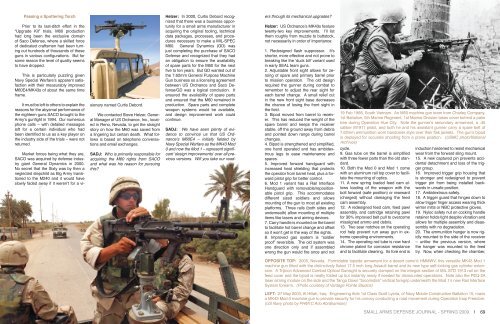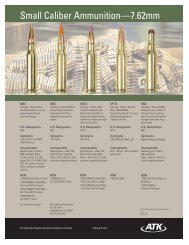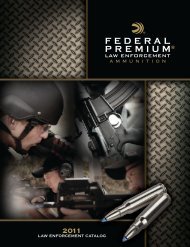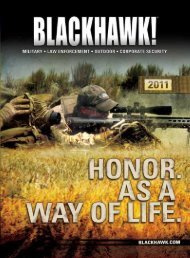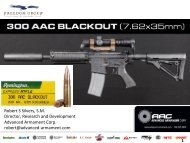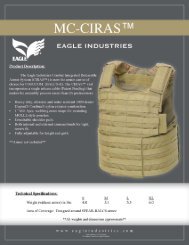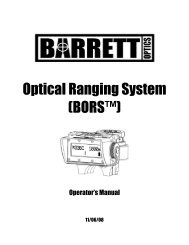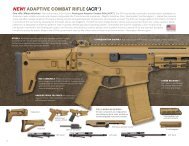MK43 - Editorial - NIOA LEM
MK43 - Editorial - NIOA LEM
MK43 - Editorial - NIOA LEM
- No tags were found...
You also want an ePaper? Increase the reach of your titles
YUMPU automatically turns print PDFs into web optimized ePapers that Google loves.
Passing a Sputtering TorchPrior to its last-ditch effort in the“Upgrade Kit” trials, M60 productionhad long been the exclusive domainof Saco Defense, where a skilled forceof dedicated craftsmen had been turningout hundreds of thousands of theseguns in various configurations. But forsome reason the level of quality seemsto have dropped.This is particularly puzzling givenNavy Special Warfare’s apparent satisfactionwith their measurably improvedM60E4/<strong>MK43</strong>s of about the same timeframe.It must be left to others to explain thereasons for the abysmal performance ofthe eighteen guns SACO brought to theArmy’s gunfight in 1994. Our numerousphone calls – with detailed messagesleft for a certain individual who hadbeen identified to us as a key player onthe industry side of the trials – were notreturned.Market forces being what they are,SACO was acquired by defense industrygiant General Dynamics in 2000.No secret that the Sixty was by then aneglected stepchild as Big Army transitionedto the M240 and it would haveslowly faded away if it weren’t for a visionarynamed Curtis Debord.We contacted Steve Helzer, GeneralManager of US Ordnance, Inc., locatedin Reno, Nevada, to get the straightstory on how the M60 was saved froma lingering but certain death. What followsis based on telephone conversationsand email exchanges.SADJ: Who is primarily responsible foracquiring the M60 rights from SACOand what was his reason for pursuingthis?Helzer: In 2000, Curtis Debord recognizedthat there was a business opportunityfor a small arms manufacturer inacquiring the original tooling, technicaldata packages, processes, and proceduresnecessary to make a MIL-SPECM60. General Dynamics (GD) wasjust completing the purchase of SACODefense and recognized that they hadan obligation to ensure the availabilityof spare parts for the M60 for the nextfive to ten years. But GD wanted out ofthe 7.62mm General Purpose MachineGun business so a licensing agreementbetween US Ordnance and Saco Defense/GDwas a logical conclusion. Itensured the availability of spare partsand ensured that the M60 remained inproduction. Spare parts and completeweapon systems would be available,and design improvement work couldcontinue.SADJ: We have seen plenty of evidenceto convince us that US Ordnance’sM60E4 – initially fielded byNavy Special Warfare as the <strong>MK43</strong> Mod0 and now the Mod 1 – represent significant‘design improvements’ over all previousversions. Will you take our readersthrough its mechanical upgrades?Helzer: US Ordnance’s <strong>MK43</strong>s featuretwenty-two key improvements. I’ll listthem roughly from muzzle to buttstock,not necessarily in order of importance:1. Redesigned flash suppressor. It’sshorter, more effective and not prone tobreaking like the ‘duck bill’ variant usedin early SEAL team guns.2. Adjustable front sight allows for zeroingof spare and primary barrel priorto mission operation. The old designrequired the gunner during combat toremember to adjust the rear sight foreach barrel change. A small relief cutin the new front sight base decreasesthe chance of losing the front sight inthe field.3. Bipod moved from barrel to receiver.This has reduced the weight of thespare barrel and keeps the receiverstable, off the ground away from debrisand pointed down range during barrelchanges.4. Bipod is strengthened and simplified,one hand operated and has ambidextrouslegs to ease maintenance andspares.5. Improved forward handguard withincreased heat shielding that protectsthe operator from barrel heat, plus a forwardpistol grip for better control.6. Mod 1 variant has a Rail InterfaceHandguard with removable/repositionablepistol grip. This accommodatesdifferent sized soldiers and allowsmounting of the gun to most all existingplatforms. Three rails (both sides andunderneath) allow mounting of multipleitems like lasers and aiming devices.7. Carry handle is mounted on the barrelto facilitate hot barrel change and offsetso it won’t get in the way of the sights.8. Improved gas system is “soldierproof” reversible. The old system wasone direction only and if assembledwrong the gun would fire once and not19 Feb 1968, South Vietnam. An M60 machine gun team from Charley Company,1st Battalion, 5th Marine Regiment, 1st Marine Division takes cover behind a palmtree during Operation Hue City. Note the gunner’s secondary armament, a .45caliber M1911 pistol, and both he and his assistant gunner carry a spare belt of7.62mm ammunition worn bandoleer style over their flak jackets. The gun’s bipodis deployed for accurate shooting from a prone position. (USMC photo/NationalArchives)cycle.9. Gas tube on the barrel is simplifiedwith three fewer parts than the old standard.10. Both the Mod 0 and Mod 1 comewith an aluminum rail top cover to facilitatethe mounting of optics.11. A new spring loaded feed cam allowsloading of the weapon with thebolt forward (safe position) or rearward(charged) without damaging the feedcam assembly.12. A redesigned feed cam, feed pawlassembly, and cartridge retaining pawlfor 30% improved belt pull to overcomemisaligned ammo and debris.13. Two sear notches on the operatingrod help prevent run away gun in extremeoperating environments.14. The operating rod tube is now hardchrome plated for corrosion resistanceand to facilitate cleaning. Its fore end isinduction hardened to resist mechanicalwear from the forward sling mount.15. A new captured pin prevents accidentaldetachment and loss of the triggergroup.16. Improved trigger grip housing thatis stronger and redesigned to preventtrigger pin from being installed backwardsin unsafe position.17. Ambidextrous safety.18. A trigger guard that hinges down toallow trigger finger access wearing thickwinter mitts or NBC protective gloves.19. Nyloc safety nut on cocking handleretainer holds tight despite vibration andallows for multiple assembly and disassemblywith no degradation.20. The ammunition hanger is now rigidlymounted to the side of the receiver– unlike the previous version, wherethe hanger was mounted to the feedtry. Now, when checking the chamber,OPPOSITE TOP: 2005, Nevada. Formidable topside armament for a desert camo’d HMMWV, this versatile <strong>MK43</strong> Mod 1machine gun fitted with the distinctively fluted 17.5 inch long Assault barrel and its new type self-locking gas cylinder extension.A Trijicon Advanced Combat Optical Gunsight is securely clamped on the integral section of MIL STD 1913 rail on thefeed cover and the bipod is neatly folded up but instantly ready if needed for dismounted operations. Note also the PEQ-2Alaser aiming module on the side and the Tango Down “broomstick” vertical foregrip underneath the Mod 1’s new Rail InterfaceSystem forearm. (Photo courtesy of Vantage Pointe Studios)LEFT: 27 May 2003, Al Hillah, Iraq. Engineering Aide 1st Class Scott Lyerla, of Navy Mobile Construction Battalion 15, mansa <strong>MK43</strong> Mod 0 machine gun to provide security for his convoy conducting a road movement during Operation Iraqi Freedom.(US Navy photo by PHM1C Arlo Abrahamson)68 | SMALL ARMS DEFENSE JOURNAL - SPRING 09 SMALL ARMS DEFENSE JOURNAL - SPRING 2009 | 69


